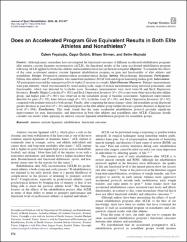| dc.contributor.author | Feyzioğlu, Özlem | |
| dc.contributor.author | Öztürk, Özgül | |
| dc.contributor.author | Sirmen, Bilsen | |
| dc.contributor.author | Muğrabi, Selim | |
| dc.date.accessioned | 2020-07-27T08:24:58Z | |
| dc.date.available | 2020-07-27T08:24:58Z | |
| dc.date.issued | 2020 | en_US |
| dc.identifier.citation | Feyzioğlu, Ö., Öztürk, Ö., Sirmen, B. ve Muğrabi, S. (2020). Does an accelerated program give equivalent results in both elite athletes and nonathletes? Journal of Sport Rehabilitation, 29(5), 572-577. https://doi.org/10.1123/jsr.2018-0346 | en_US |
| dc.identifier.issn | 1056-6716 | |
| dc.identifier.issn | 1543-3072 | |
| dc.identifier.uri | https://doi.org/10.1123/jsr.2018-0346 | |
| dc.identifier.uri | https://hdl.handle.net/20.500.12511/5608 | |
| dc.description.abstract | Context: Although many researchers have investigated the functional outcomes of different accelerated rehabilitation programs after anterior cruciate ligament reconstruction (ACLR), the functional results of the same accelerated rehabilitation program following ACLR applied for both elite athletes and nonathletes have not yet been investigated. Objective: To examine the effects of the same accelerated anterior cruciate ligament rehabilitation program on pain and functionality of elite athletes and nonathletes. Design: Prospective preintervention-postintervention design. Setting: Physiotherapy department. Participants: Fifteen elite athletes and 15 nonathletes who underwent unilateral ACLR with autologous hamstring tendon graft. Intervention: All participants received the same protocol for 6 weeks (5 sessions in a week). Main Outcome Measures: Primary measurements were pain intensity, which was measured by visual analog scale, range of motion measurement using universal goniometer, and functionality, which was detected by Lysholm score. Secondary measurements were short form-36 and Beck Depression Inventory. Results: Higher Lysholm (P = .001) and Beck Depression Inventory (P = .03) scores were observed in the elite athlete group, and higher pain (P = .001) was observed in the nonathlete group at baseline assessments. Significant improvement detected for pain (P < .05), knee flexion range (P < .05), Lysholm score (P < .05), and Beck Depression Inventory (P < .05) compared with preintervention for both groups. Finally, after comparing the mean change values, the nonathlete group displayed greater decrease in pain level (P = .01) and participants in the elite athlete group further showed a greater decrease in depression level (P = .001). Conclusions: This study found that the same accelerated rehabilitation protocol provides significant improvements for pain, functionality, and depression in both elite athletes and nonathletes after ACLR. Clinicians should consider our results when applying an anterior cruciate ligament rehabilitation program for nonathlete groups. | en_US |
| dc.language.iso | eng | en_US |
| dc.publisher | Human Kinetics Publishers Inc. | en_US |
| dc.rights | info:eu-repo/semantics/embargoedAccess | en_US |
| dc.subject | Anterior Cruciate Ligament | en_US |
| dc.subject | Rehabilitation | en_US |
| dc.subject | Functional Outcomes | en_US |
| dc.title | Does an accelerated program give equivalent results in both elite athletes and nonathletes? | en_US |
| dc.type | article | en_US |
| dc.relation.ispartof | Journal of Sport Rehabilitation | en_US |
| dc.department | İstanbul Medipol Üniversitesi, Sağlık Bilimleri Fakültesi, Fizyoterapi ve Rehabilitasyon Bölümü | en_US |
| dc.identifier.volume | 29 | en_US |
| dc.identifier.issue | 5 | en_US |
| dc.identifier.startpage | 572 | en_US |
| dc.identifier.endpage | 577 | en_US |
| dc.relation.publicationcategory | Makale - Uluslararası Hakemli Dergi - Kurum Öğretim Elemanı | en_US |
| dc.identifier.doi | 10.1123/jsr.2018-0346 | en_US |
| dc.identifier.wosquality | Q3 | en_US |
| dc.identifier.scopusquality | Q2 | en_US |


















